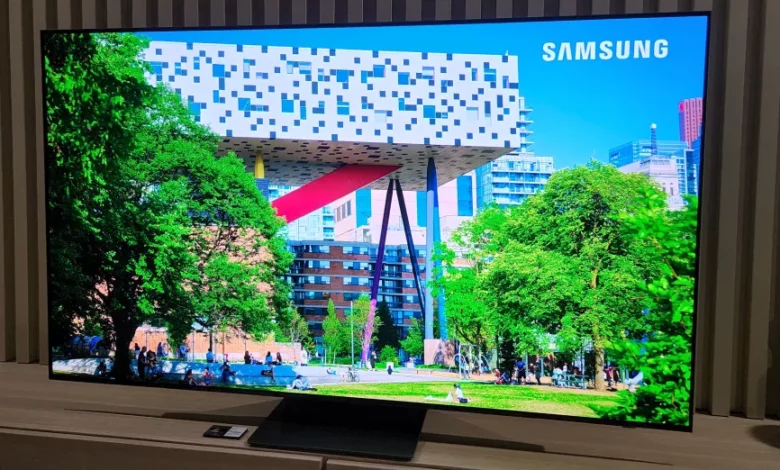
Can Samsung improve upon OLED’s already stellar image quality?
Our Verdict
We’ve only spent a little time with it, but the Samsung S95B QD-OLED TV appears to deliver on the promise Samsung has made: by combining quantum dots with OLED, the company has built a better mousetrap. With wireless Atmos and top notch image processing, it’s a premium set at a premium price – but quality is worth paying for, right?
For
- Wireless Dolby Atmos
- Vivid colors
- Incredible black levels
Against
- Only 55- and 65-inch versions
- Premium price tag
For years, TechRadar has offered the same advice: If you’re looking for the best TV you can possibly find, buy yourself an OLED set. OLED offers perfect black levels and the contrast ratios to match, and while the pictures aren’t as bright as those from LED televisions, they’re simply stunning.
And for years, regardless of which TV manufacturer you bought from – LG, Sony, Philips, whoever – the panel in your set came from one place: LG Display. Until now.
With the release of the S95B, Samsung has dipped a toe into the OLED display market, using a new panel technology that combines the best of both worlds. The QD-OLED panel in the S95B, manufactured by Samsung Display, combines the deep black levels and impossible contrast ratios of OLED with the brightness and wide color gamut of quantum dots, which the company describes as the secret sauce in its flagship displays, such as the Neo QLED 8K TV.
Given the Chinese companies like Hisense and TCL eating away at the LED TV market, one might conclude that a fancy new technology like QD-OLED is the future for Samsung Display. And at a private screening in lower Manhattan last week, TechRadar was given a glimpse of that future. And truly, it was something to behold.
Samsung S95B: Design and Features
If you’ve been coasting on the same TV for five or *gasp* ten years, you probably haven’t noticed the revolution in bezels that has made today’s TVs so elegant. Advances in manufacturing technology let companies like Samsung produce televisions with the barest wrapping of metal around the screen itself, minimizing everything but the latest episode of The Marvelous Mrs. Maisel or whatever you happen to be binging.
The S95B is no exception, with tiny metal bezels and slim metal base that accentuate the screen itself. OLED is inherently thinner than LCD, with fewer layers and substrates making up the panels, hence OLEDs are really thin. The S95B pushes this to a level I’ve never seen before; Samsung calls it a LaserSlim Design, and with a glance, you can forgive them for the hyperbole. The S95B is about as thin as a USB cable, with electronics and circuit boards in a bump-out around the pedestal base. It’s quite something.
That also means it’s light: The 65-inch model weighs 47.8 pounds, without the stand. I tried to pick it up and was given a stern talking to, which is fair: I shouldn’t be mucking with one of only two models in the country.
There’s no One Connect box to be found here, unfortunately. One Connect box is a great connectivity feature from other fancy Samsung models that ties all the ins and outs into an external box, keeping things clean. Instead, you’ll find 4 HDMI 2.1 ports and … well, that’s about it.
Samsung bolsters the I/O capabilities by including Wireless Dolby Atmos, which means you won’t need that cable out to your soundbar … if you’ve got a new-enough model from Samsung that supports that feature, of course.
Samsung S95B: Performance and Image Quality
After first laying eyes on the Sony A95K TV at the beginning of March – which appears to use the same Samsung panel, though neither company wants to say that explicitly – we told you that QD-OLED lives up to the hype. But allow me to reiterate: QD-OLED lives up to the hype.
While watching a demo reel endlessly cycle, I was struck by the incredible color range. The S95B goes beyond 100% of the DCI-P3 color space, a fancy way of saying it’s got enormous range. Images of a lizard on a stick, bright red and orange leaves in the fall, the deep blue skies over a remote mountain, the deep green leaves in the forest – all of it practically leapt off the screen.
That’s because of the quantum dots, you see. How do they work? On paper, QD-OLED sounds so simple. You take a blue self-luminescent layer, throw on a film of quantum dots, and then add a glass screen to the front. Have some signal processing happening in the base of the TV, throw some inputs on the back and voila! You have a QD-OLED.
Meanwhile, the S95B maintains those deep blacks that OLED screens are famous for, black levels so deep you can lose yourself in them. It’s one heck of a combination.
Another thing worth noting is the impressive off-axis viewings: With the S95B, colors remain remarkably vibrant even all the way off to the side, something that other sets struggle with. Even when viewed from the edge on, at approximately 80 degrees, colors appear more or less true. Sure, you can’t make out what’s on-screen, but it’s a good sign that you won’t have to fight over “the good seat” on the couch.
That great image is powered by what Samsung calls a Neural Quantum Processor with 4K Upscaling. Samsung says AI and neural networking built into the chip can analyze the content on-screen and intelligently optimize it for the display. It can upscale, brighten, sharpen, and otherwise optimize content – and increasingly, the power of processors like this will be the differentiator between ordinary TVs and great ones. It’s easy to dismiss this as mere marketing hype, but having experienced slow TVs limping by on underpowered processors, and having seen the power of great algorithms, this isn’t something to overlook. We look forward to more testing when we receive a review unit.
Samsung S95B: Price and Availability
For its first foray into QD-OLED screens, Samsung is offering only 55- and 65-inch models; there’s no Jumbotron version for those seeking a home theater experience, and likewise nothing in the 40-inch scale for those of us with “ordinary” rooms.
The 55-inch model – officially the QN55S95B – will sell for $2,200 US (around £1,670 / AU$2,980), while the 65-inch model (cleverly named the QN65S95B) – will go for $3,000 US (around £2,275 / AU$4,040). Both will go on sale in mid-April.
FWIW, those prices are better than originally anticipated: Samsung accidentally pulled the trigger on the announcement with steeper prices, and quickly corrected itself.
Early verdict
Last month, Sony unveiled QD-OLED screens in similar sizes, but with substantially higher price tags. Similar sizes, unique new screen technology … who could be making Sony’s panels, one wonders?
Both screens appear at first blush to have an edge on OLED alone, although both carry a higher sticker because of it. We look forward to deeper testing of both models to determine just what impact those algorithms, AI, and image processors have on the image you see. But one thing seems clear: the bar has been set. And regardless of which is the best set around – or perhaps neither wins in the end – new technologies and improvements like this can only mean good things for TV viewers like you and me.







![[1/3]An AI (Artificial Intelligence) sign is seen at the World Artificial Intelligence Conference (WAIC) in Shanghai, China July 6, 2023. REUTERS/Aly Song/File Photo Purchase Licensing Rights, opens new tab](https://www.ghanaiantimes.com.gh/wp-content/uploads/2024/03/Screenshot-2024-03-11-at-09-10-00-AI-talent-war-heats-up-in-Europe-e1710148354659-220x150.png)